What to do for bacteriosis of cucumbers - treatment with effective methods
The disease known as bacteriosis of cucumbers has a second name - angular leaf spot (due to the characteristic shape of the spots). The pathogen is especially harmful during periods of prolonged rain when growing crops in open ground, as well as during high humidity and low air temperatures in a greenhouse. With large-scale infection of plantings, yield losses reach 50%.
In this article we will talk about bacteriosis of cucumbers, the causes of the disease, methods of its treatment and prevention.
What is bacteriosis of cucumbers
Bacteriosis is a bacterial disease caused by the pathogen P. syringae pv. lachrymans. The gram-negative bacterium resembles a rod with rounded ends, does not form spores, and has flagella. The size of the pathogen is 0.8 x 1.0–2.0 microns.
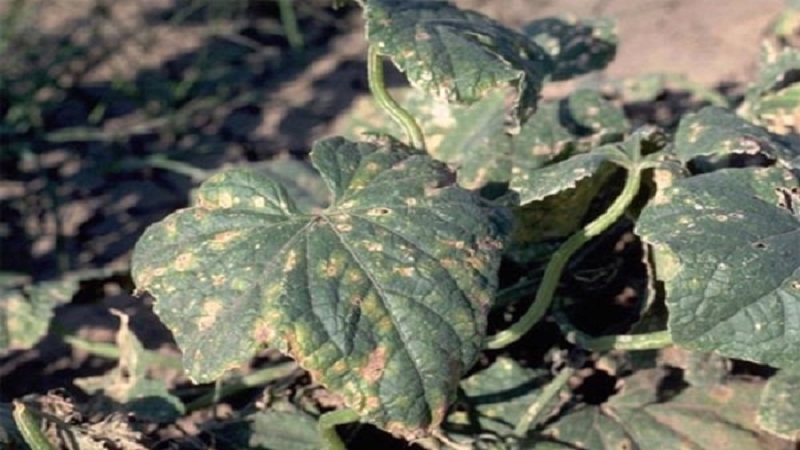
Distinctive feature of the bacterium - the ability to form protective capsules, which ensure its increased survival in an unfavorable environment.
The pathogen penetrates plant tissue through small wounds and leads to necrotic lesions. The incubation period is 4-5 days.
Weak shoots with a small number of flowers appear from infected seed material. The plants produce low-quality cucumbers. The pathogen spreads from cotyledon leaves to real leaves in the form of single necrosis.
Bacteria develop only on plant tissues. On rotten weeds they remain active for a long period, but die in the soil.
The photo shows plants and fruits affected by bacteriosis.
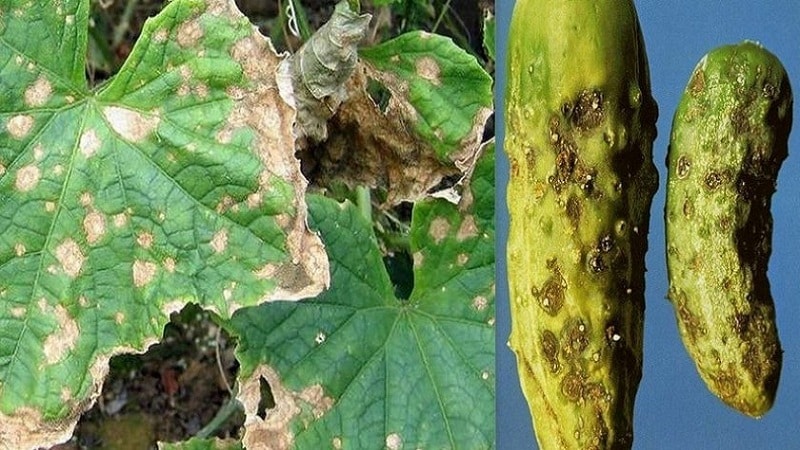
Symptoms
Signs of corner spot:
- small weeping light brown spots on the cotyledons;
- yellowing of the leaf surface;
- necrosis on greenery;
- deformation of cotyledons;
- death of seedlings in the ground;
- sticky cloudy yellow drops on the back of the leaves (exudate), which, as they dry, turn into brown spherical drops;
- wilting of leaves;
- perforation of dried areas;
- death of plant tissue;
- shallow round ulcers on fruits;
- distortion of the shape of cucumbers;
- the appearance of cloudy liquid from ulcers during periods of prolonged rain;
- rot inside the fruit.
Harm to plants and humans
The danger of bacteriosis of cucumbers is loss of yield. Infection of plants leads to a delay in the growth of cucumber bushes, a decrease in fruit formation, and a deterioration in the commercial quality and taste of cucumbers. Yield loss reaches 50%, since infected cucumbers do not enter the stage of biological ripeness.
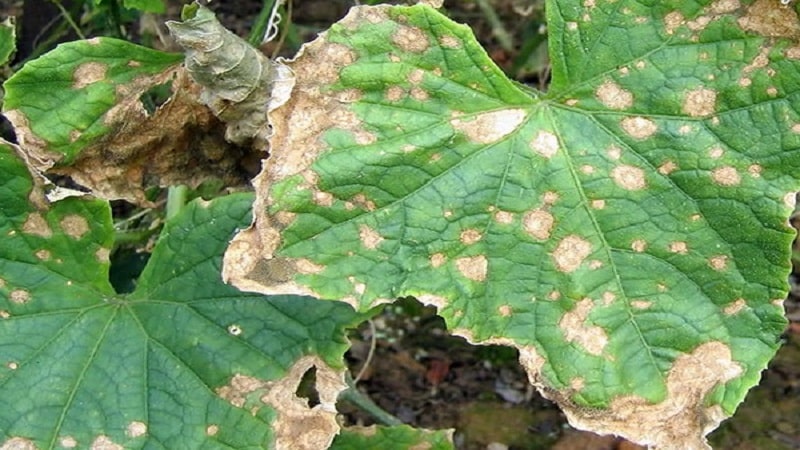
Bacteriosis leads to partial or complete death of bushes. Often the disease is accompanied by brown spot (cladosporiosis), increasing the negative impact on the crop. There is scientifically confirmed evidence that conidia (non-motile spores) of Cladosporium cucumerinum stick to drops of dried exudate and spread through the air.
Bacteriosis of cucumbers not dangerous for humans, but diseased fruits are not recommended for consumption. In any case, this does not make sense, because cucumbers lose their attractive appearance and taste.
It can be useful:
Causes of bacteriosis of cucumbers and favorable conditions for its development
The rapid spread of the pathogen in the area contributes to:
- temperature;
- humidity;
- priming;
- seeds.
The main source of infection is seeds collected from infected cucumbers.. Bacteria are active on the surface of the seed and under the shell. The pathogen remains viable for about 20 months.
Massive infection of plantings occurs in closed spaces, for example, in film greenhouses. In an open area, bacteria are spread by currents of air, water, and by people in the process of caring for plants.
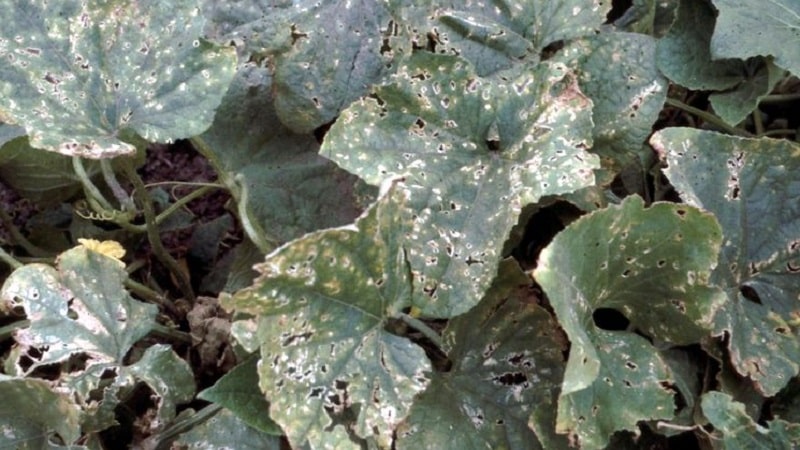
Active reproduction of bacteria begins at a temperature of +19…+25°С. The pathogens spread not only by air, but also through the ground. An excess of nitrates is a favorable environment for the development of colonies. Bacteria feed on nitrates. As a result, nitrites are formed, accumulating in the upper layer of soil.
Increasing air humidity to 70% and maintaining this indicator over the course of 2-3 weeks, it greatly increases the risk of plant infection with bacteriosis.
Treatment methods
Treatment of plants infected with the pathogen P. syringae pv. lachrymans., comes down to pre-planting seed treatment, spraying plants with chemicals in case of mass infection, using folk remedies for irrigating young foliage.
Chemical treatment
Seed disinfection is carried out using:
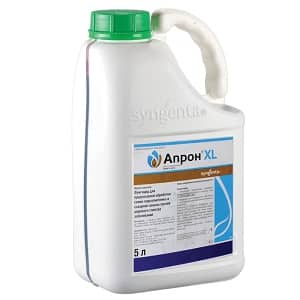 fungicide "Apron XL" - 2.5 ml/kg;
fungicide "Apron XL" - 2.5 ml/kg;- mineral 0.03% solution with potassium permanganate, zinc, copper, iron;
- solution of 0.02% zinc sulfate for 24 hours.
Therapeutic spraying is carried out when the first symptoms of the disease appear, using fungicides with bacteriostatic and bactericidal action:
- “Medyan Extra” - 2–2.5 l/ha;
- "Infinito" - 1.2–1.6 l/ha;
- "Acrobat MC" - 2 kg/ha;
- "Metaxil" - 2.5 kg/ha;
- "Ridomil Gold" - 2.5 kg/ha;
- "Quadris" - 0.6 l/ha;
- "Previkur" - 2 l/ha;
- “Fital” - 2–2.5 l/ha;
- "Aliette" - 2 kg/ha;
- “Plant healer” - 10–25 g/5–8 l of water;
- "Etafol" - 10–20 g/10 l of water.
Highly effective against bacteriosis of cucumbers preparations with copper:
- “HOM”, “Oksikhom” - 40 g/10 l, 1 l per 10 m²;
- copper sulfate - 100 g/10 l of water;
- "Ordan" - 2.5–3 kg/ha;
- "Kurzat R 44" - 3 kg/ha.
Often, a single spraying of the plantings is sufficient.. Repeated treatment is carried out if necessary, observing the dosage and measures to protect the skin, eyes and respiratory organs.
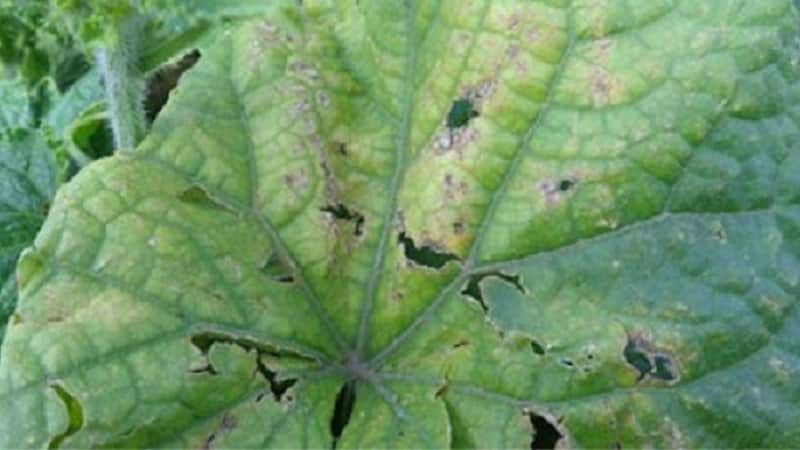
Biological products
To prevent bacteriosis of cucumbers, seeds are soaked in biological products:
- "Agat 25-K" - 9 g/kg;
- “Pseudobacterin-2” - 0.1 l/kg;
- “Phytocide” - 2.5 ml/kg.
Products based on Bacillus subtilis are highly effective. Their advantage is that they are safe for human health and the environment. The bacterium Bacillus subtilis suppresses the vital activity of many fungi and bacteria in the early stages of diseases.
Treatment with drugs stimulates plant growth and reduces seed germination time, increases yield by 20–30%. Fruits after therapeutic and preventive spraying can be immediately eaten.
Reference. Preparations with Bacillus subtilis have a short period of action on pathogens and lose their healing properties in the air. Therefore, treatments are carried out 4-5 times during the growing season.
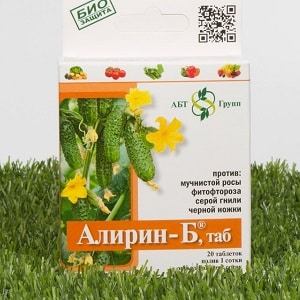 The most effective biological products:
The most effective biological products:
- "Alirin-B";
- "Gamair";
- "Baktofit";
- «Fitosporin-M»;
- "PhytoDoctor"
Remedies with hay bacillus are available in any gardening stores, but they can be easily prepared yourself from rotted hay, water and chalk.
Cooking technology:
- Rotten hay or hay dust is laid out in the shade and sprayed with water 2-3 times a week.
- After 3 weeks, mold-free rot is selected and finely chopped.
- To prepare the mother culture, take 1 tsp. crushed chalk, 100 g of hay, pour 1 liter of water, put on low heat and boil for 15–20 minutes. This allows you to kill all pathogenic microflora, except for Bacillus subtilis, which is not afraid of boiling temperatures. The broth is left to brew in a warm place for 3-4 days to increase the number of bacteria. The appearance of a film on the surface indicates the product is ready.
- To prepare the infusion, take 1 kg of hay, 5 tbsp. l. lime, mother culture and add 5 liters of water. Cover with a lid and leave for 3-4 days in a warm place.
There is an easier way to create a favorable environment for the development of Bacillus subtilis - mulching the beds with hay. Dark and humid environments, moderate temperatures, and decaying organic matter contribute to an increase in the bacterial population.
Read also:
Folk remedies
For the treatment of young shoots and plants that have entered fruiting, use products based on onion peels or boric acid:
- A clean liter jar is filled with onion peels and filled to the brim with warm, clean water. Leave to brew in a warm place for 48 hours. Then the infusion is poured into a separate container, the husks are squeezed out and the liquid is filtered through cheesecloth. To prepare the working solution, the infusion is diluted with water in a ratio of 1:5. Spraying is carried out in the evening, before sunset. The frequency of treatments is 1 time every 10 days until the disease completely disappears.
- Dissolve 1 tsp in 10 liters of water. boric alcohol and brilliant green.The liquid is thoroughly stirred and used to treat cucumbers once every 20 days until the bacteriosis completely disappears.
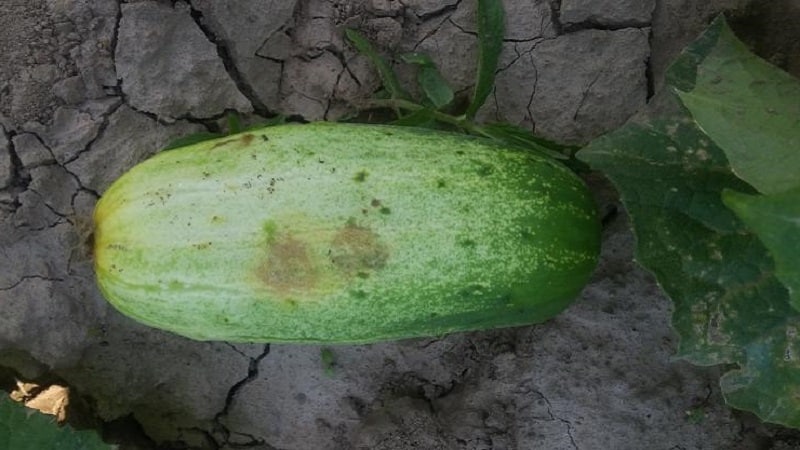
Destruction of affected plants
In case of large-scale spread of the disease and lack of the expected result treatment, diseased plants are removed by the roots, removed from the site and burned. Then the soil is dug deep - the infected plant debris will rot before the next season, and the pathogen will die from the cold.
Preventive measures
Measures to prevent infection of cucumbers with bacteriosis:
- planting plants in illuminated areas - the bacterium dies at temperatures above +35°C within an hour;
- growing crops on a trellis;
- weeding and loosening beds;
- selection of varieties resistant to disease;
- disinfection of seeds before sowing for seedlings;
- fertilizing with organic matter - compost and humus once every 2 weeks;
- feeding with minerals - superphosphate, urea, potassium salt once every 2 weeks;
- collecting seeds from healthy fruits;
- cleaning of plant residues;
- crop rotation;
- reduction of humidity to 65% when growing crops in a greenhouse;
- disinfection of greenhouses and greenhouses with bactericidal solutions;
- spraying plantings with preparations containing copper.
Advice from experienced gardeners
Bacteriosis of cucumbers is one of the common diseases, which almost every gardener has to deal with.
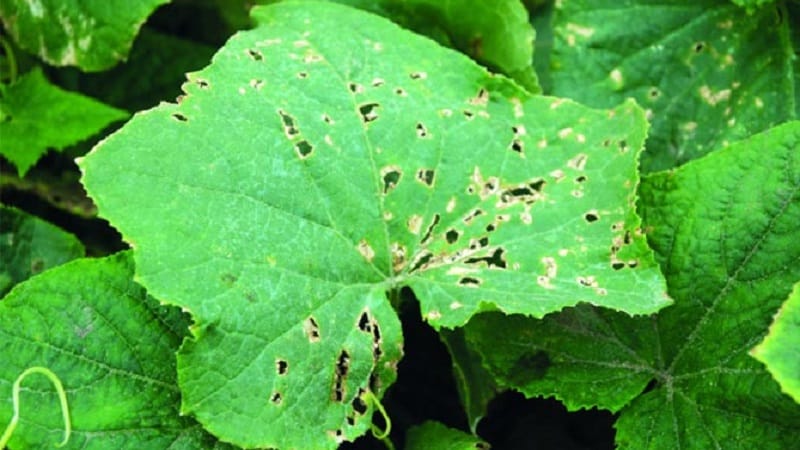
On thematic forums farmers share tips on preventing and treating disease:
- Choose the location for planting your cucumbers carefully. It is important that it is illuminated by the sun from all sides.
- Tie the lashes to the trellis. This will create additional aeration for the plantings.
- Use clean water at room temperature for irrigation.
- Maintain crop rotation.If cucumbers suffered from bacteriosis last season, choose a different area for planting, for example, after legumes.
- Choose varieties and hybrids with relative resistance to the pathogen (Nezhensky, Konkurent, Dalnevostochny, Octopus F1, Lesha F1, Masha F1).
Conclusion
The causative agent of cucumber bacteriosis remains viable for about 20 months. In the fight against a pathogen, infection prevention plays an important role. Healthy and strong plants are less susceptible to disease compared to weakened bushes.
Pre-sowing treatment of seeds, periodic spraying of plantings with copper-containing products and biological products, fertilizing with organic matter and minerals will help maintain the health of the plant. In case of mass infection, heavy artillery is used - chemicals (Medyan Extra, Infinito, Acrobat MC, Metaxil, Ridomil Gold, Quadris, Previkur).